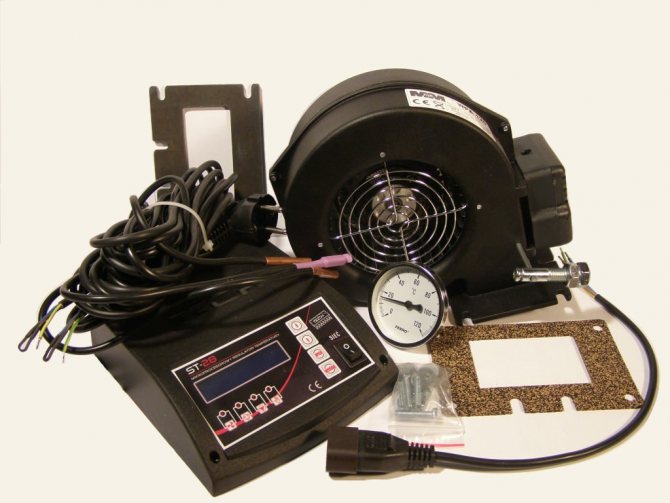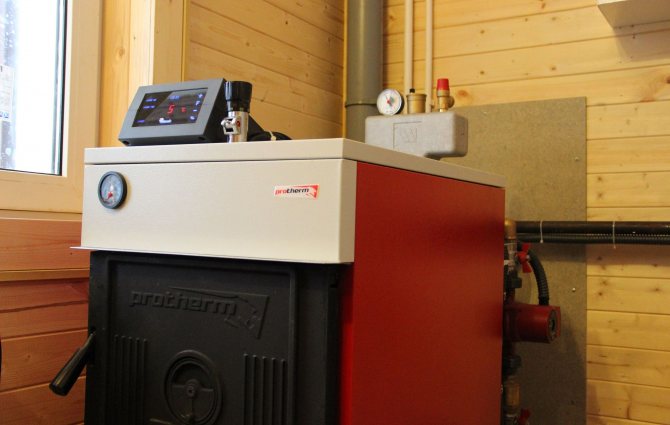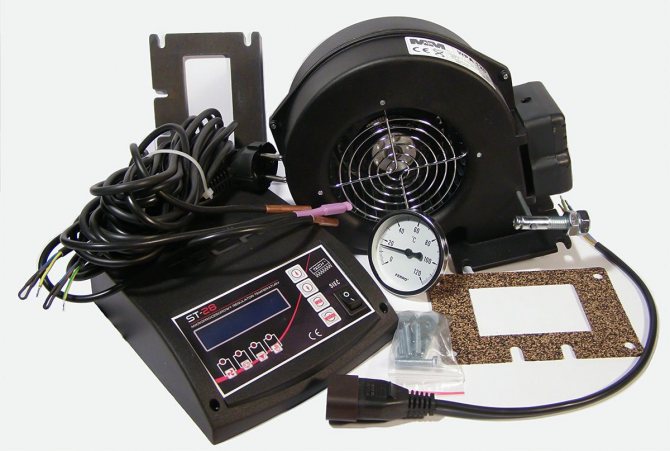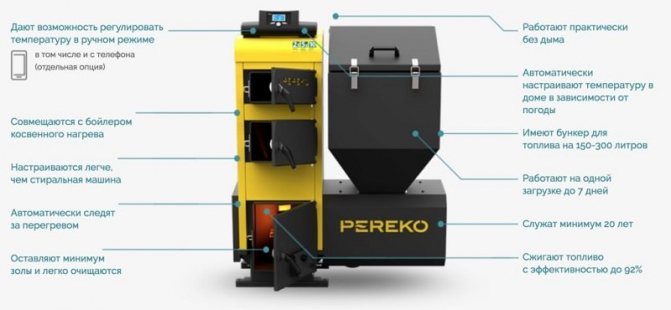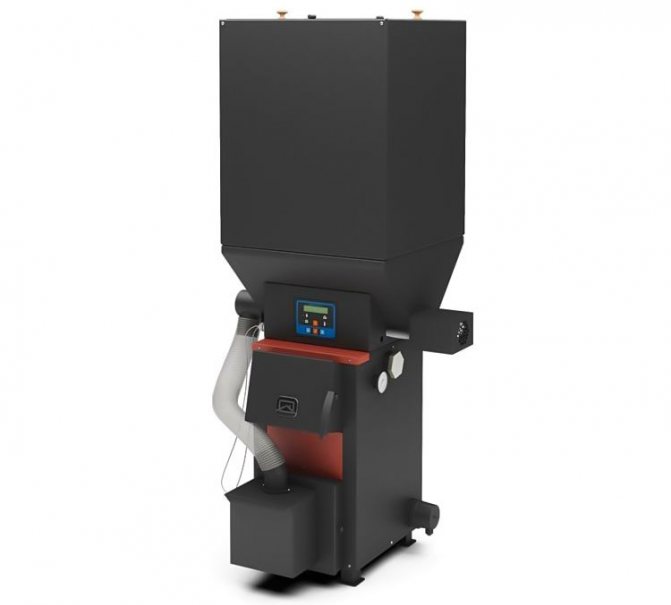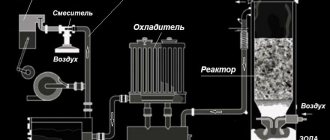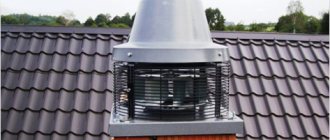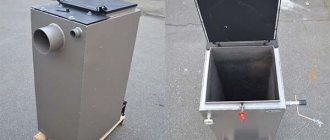Home / Solid fuel boilers
Back to
Published: 24.05.2019
Reading time: 7 minutes
0
1065
In the absence of an opportunity to connect to a centralized gas supply system, the owners of private houses and summer cottages decide to install an automatic solid fuel boiler.
Firewood, coal, peat or sawdust (pellets) are used as fuel in such units. But since manual loading of the listed raw materials becomes difficult, many consumers prefer devices with automation of such a process.
- 1 The principle of operation of automatic boilers for long burning
- 2 Difference from semi-automatic boilers
- 3 Internal structure
- 4 Types of automatic boilers
- 5 Requirements for the installation of an automatic solid fuel boiler
- 6 5 best boilers with automatic fuel supply
Content
- Automation for solid fuel heating boilers
- Automation processes
- Automation for a heating boiler (types and device)
- Manual boilers with automation
- Boilers with automatic solid fuel supply
- Solid fuel boilers for long burning
- Automation for anthracite boilers
And yet, the majority of the population is discouraged by the maintenance of solid fuel boilers, which must be done every 3-4 hours. Due to the fact that the fuel burns quickly, it is necessary to regularly throw coal or wood into the firebox. Ash pan cleaning is also a laborious process and not the most pleasant one. And the regulation of temperature is a whole problem: for this, the owner must correct the position of the damper, with the help of which the flow of air masses into the furnace is controlled.
Now, thanks to automation, all these processes can be performed less frequently or remotely, while saving money on electricity and gas.
Automation for solid fuel heating boilers
The invention of automation, which makes the maintenance of the unit easier and more convenient, made it possible for solid fuel boilers to become competitive again. Moreover, such equipment can be installed on almost all models of boilers for heating.
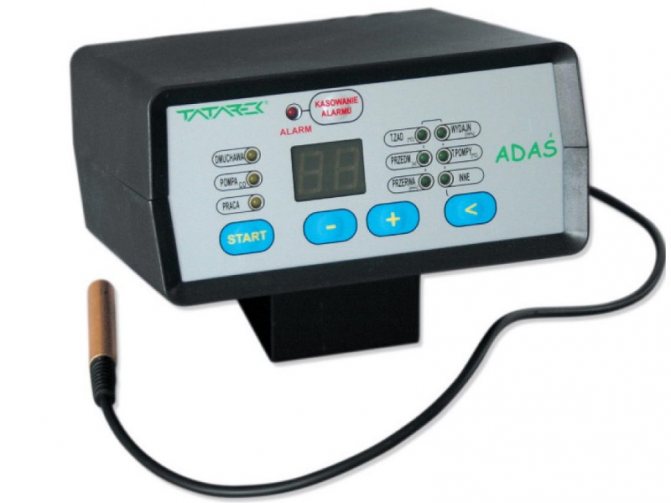
Automation for solid fuel boilers can be installed in almost all models
Automation processes
- This function will be performed automatically.
- Automation simplifies the regulation of the temperature of the solid fuel heating system: the procedure is reduced to setting the CH and DHW indicators. Further, in the boiler, with the help of special equipment (pump, fan, etc.), the regulation of the air supply is started, which does not require human intervention. When the solid fuel device cools down by more than 10 degrees, combustion intensifies, and if it is necessary to reduce the temperature, simply air is supplied in smaller portions. Thus, the automation will help save fuel and at the same time maintain a comfortable temperature in the room. It also allows you to leave the unit turned on for a minimum during your absence so that the room does not cool down.
- Another advantage of the automation is the security system, which, in the event of a malfunction of the boiler, turns off the device and notifies the residents of the malfunction with a sound signal. This allows you to quickly eliminate malfunctions that have arisen in the functioning of the unit.
- Since the automation makes a solid fuel boiler dependent on electricity, manufacturers have provided for cases of power outages.The device will be able to work autonomously even without power supply for a certain period of time.
- In modern models of automatic boilers, it is even possible to load fuel without human intervention. To do this, they are equipped with a special bunker designed for storing fuel, from which firewood or coal automatically goes into the furnace. The only drawback is that such a system requires the fuel to be of a certain type and size. The ash cleaning function can also be performed automatically.
- Automation allows you to control the heating system using a control panel, which will reduce your visits to the boiler room to a minimum.
What tools to buy in order to weld heating pipes like clockwork? If the choice fell on stainless steel pipes, then read about the installation here.
The most accurate calculation of the diameter of the heating pipe at the link: https://prootoplenie.com/otopitelnoe-oborudovanie/truby/diametr-trub.html
Basic functions of boiler safety automation
The functional purpose of the automatic units operating in the system is determined by the ability to reconfigure the unit's modes for changing parameters. The main purpose of using gas valves controlled by sensors is to stop the supply of fuel (gas) to the working area.
An autonomous termination of the gas flow is carried out in cases when the following occurs:
- malfunctions of the exhaust system, accompanied by a deterioration in traction and the likelihood of penetration of harmful exhaust into the room;
- sudden pressure drops recorded in the supply of the main gas pipeline, which are determined by the gas pressure regulator;
- damping of the flame in the pilot burner, which is fixed by the thermostat.
If these reasons occur, the regular gas supply is stopped. It is produced on autonomous gas boilers using valves triggered by built-in sensors.
According to the existing operating standards, for heating carried out by gas boilers, all operating installations must be provided with security systems. The same rules apply for boiler manufacturers who are obliged to equip gas burners intended for heating furnaces with modern control systems.
It is worth taking into account that it is often cheaper to install new equipment than to organize the re-equipment of the automation of old-style gas units that are not suitable for use according to existing standards. The reason for the difficult replacement is the structural differences between the device of the old-style sensors from the technology produced today.
Automation for a heating boiler (types and device)
Manual boilers with automation
For the operation of a manual boiler, coal is placed on an already burnt layer. The intensity of heat transfer is regulated by manually opening / closing the damper.
This class of heating units has its advantages: such boilers are easy to manufacture and quite simple to operate, they are relatively inexpensive and can consume both different types of coal and firewood.
The disadvantages include low heat transfer at high fuel costs, the need to often add firewood / coal. At the simplest level, this type of boiler can be improved by the appearance of a thermostat that controls the degree of flap lift when the temperature changes. More sophisticated models are equipped with a fan and a thermometer, which are controlled by a simple regulator.
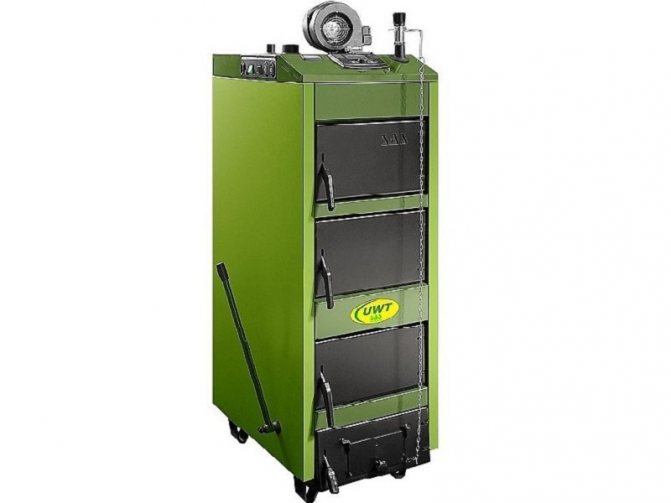

Manual boiler with automation
Boilers with automatic solid fuel supply
This type of automated boilers is represented by screw units, the mechanism of which consists of the location of the fuel - a bunker (pits or just a room where pellets or pea coal are stored), a screw (auger conveyor) that supplies fuel to the burner, a heat exchanger and a furnace. This type of boilers is represented by a huge number of diverse models.
How to efficiently and quickly make greenhouse heating with your own hands in your home? The best and most reliable double-circuit turbocharged gas boiler, we select here.
Take care of stoves, make stove heating in a private house with your own hands, instructions at the link:
A significant disadvantage of this type of product is the impossibility of operating such units based on the combustion of anthracite and the need to use long-flame coal. On the other hand, the advantage of screw boilers is that pellets (pellets from wood chips and waste) can act as an alternative to coal. Today it is wood waste that is called one of the most economical, energy-saving and environmentally friendly fuels.
There are boilers with a pneumatic fuel supply system, which is based on a compressor for supplying air in pneumatic lines, resembling a vacuum cleaner in type. Interestingly, such a structure is capable of transferring fuel over distances of up to 1000 cm and up to 250 cm in height.
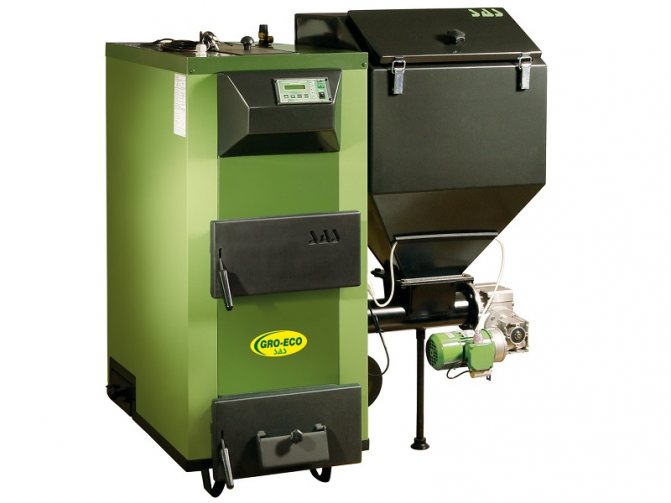

Boiler with automatic solid fuel supply
Solid fuel boilers for long burning
Boilers of this type have a great advantage due to the increased volume of the furnace. A feature of such devices is the installation of heat-resistant parts in the combustion chamber, which improve the quality of combustion of solid fuel. Conventionally, this type of heating device is divided into three subspecies:
- classic boilers with an increased furnace volume;
- upper combustion pyrolysis boilers;
- bottom combustion boilers.
On average, at one load, such units can work up to 26 hours. Leading manufacturers of solid fuel boilers have developed models that can function for up to 5 days without additional fuel supply, and the efficiency of such units reaches 90%. In pyrolysis boilers, wood gas burns, the release of which is the result of exposure to high temperatures. It is blown through the nozzles and burns with a colorless flame.
The advantages of pyrolysis boilers include a small amount of ash formed as a result of combustion and high efficiency. The disadvantages are the high price and the need to use only very well dried firewood.


Long burning solid fuel boiler
Automation for anthracite boilers
This type of aggregates is not widespread, since anthracite is found mainly in the territories of Russia, Ukraine, and China. The principle of operation of this equipment is based on obtaining heat when processing this type of coal.
The advantages of such boilers include the comparative cheapness of fuel and its wide distribution in our country.


Automated anthracite boiler
The design of devices and a description of the principle of their operation
Devices that correct the operation of the system that ensure the safety of boilers are created either in a built-in mechanical form or in an external electronic version. Mechanical systems are most often used in the equipment of the budget group of household goods, they involve manual control.
And the installation of automation with electronic units is used in modern gas boilers, they are able to perform manipulations in an independent mode, without additional intervention.
However, mechanical systems are distinguished by their simplicity and reliability, which excludes malfunctions, which is why they continue to be popular. To establish which automation is better, it is necessary to conduct a comparative analysis.
Mechanical sensors
Mechanical control units are simple in design. Maintenance or repair of these gas automation systems is straightforward. An ordinary heating engineer who maintains gas heating boilers in this area is capable of adjusting these systems.
In addition, mechanical elements do not depend on additional power sources.The user adjusts them to the necessary parameters, and the control is carried out by sensors, thanks to the physical properties of the working elements.
Typically, the response valve of such a sensor consists of a thermocouple made up of two metals - steel on one side and nickel on the other. This design makes it possible to change the shape of the reacting element depending on the temperature. This system is used to open or close a valve that supplies gas to the burner.
The same principle applies to the operation of an autonomous draft regulator used in boilers with a standard open combustion chamber.
Here, the purpose is carried out by a bimetallic plate, which bends when the maximum temperature is reached, opening the circuit.
After the heating temperature drops, the plate takes on its original shape, closing the circuit again, continuing to work for a long time and eliminating the likelihood of breakage.
Electronic devices
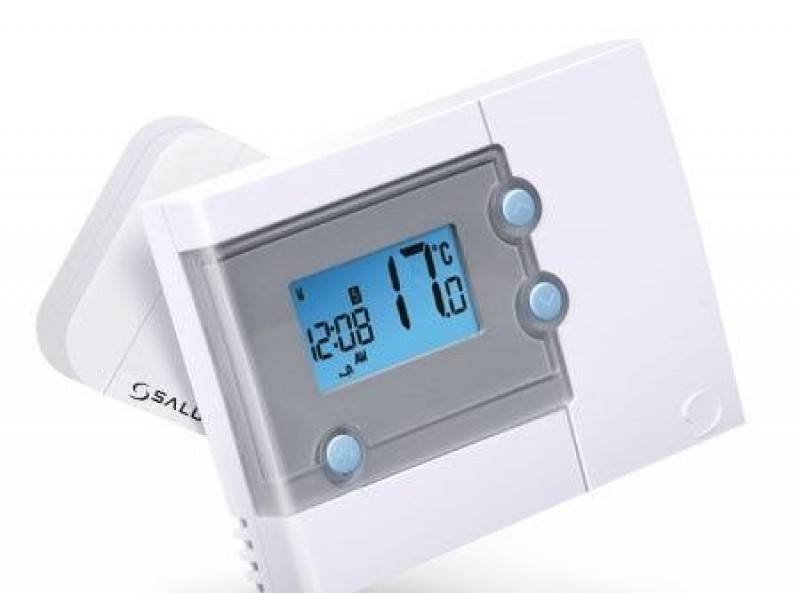

Systems for gas automation with electronic filling are arranged differently, the operation of which is not associated with the physical state of materials, which changes under the influence of the environment. Here, the automation of the installed gas boiler works according to a different principle of transmitting signals that allow you to adjust the position of the valves.
Usually, in such cases, an electronic thermostat is installed, which is located outside the structure of the unit on the territory of a bath, boiler room or living room.
Such sensors are capable of monitoring temperature changes inside the heated room, making periodic shutdowns of the steam or hot water boiler, depending on the heating of the air.
When the limit is reached, the sensor sends a signal to stop heating. And after the temperature reaches the lower permissible value, a new signal resumes the operation of the unit, carrying out full automation of the process.
Thermostats, installed in any convenient place in the room, are connected to the boiler circuit by means of a cable. Today, in the assortment of these devices, you can find sensors of various designs, they are distinguished, both by technical characteristics or setting modes, and by the method of installation. Programmable devices are capable of providing an optimal temperature regime for a room for a specified period of time, without additional verification of safety automation.
Among other devices, there are also wireless sensors that control the operation of heating equipment remotely. Depending on the selected model, the range can be calculated from 25 to 100 meters.
Principles of operation of boilers with automation elements
An important role in the operation of a solid fuel boiler is played by a firebox, which serves as a heat exchanger. It is here that the combustion of fuel takes place.
Around this structural element is a water jacket, which is heated by the hot walls of the fuel. Subsequently, this water enters the pipes and radiators. In this case, the liquid circulates by gravity without any special pumps.
The intensity of combustion of a solid fuel boiler can be adjusted manually, using a gate, or using mechanical dampers. If you want to increase the temperature in the room, then you need to raise the damper, which will increase the air flow and speed up the combustion process.
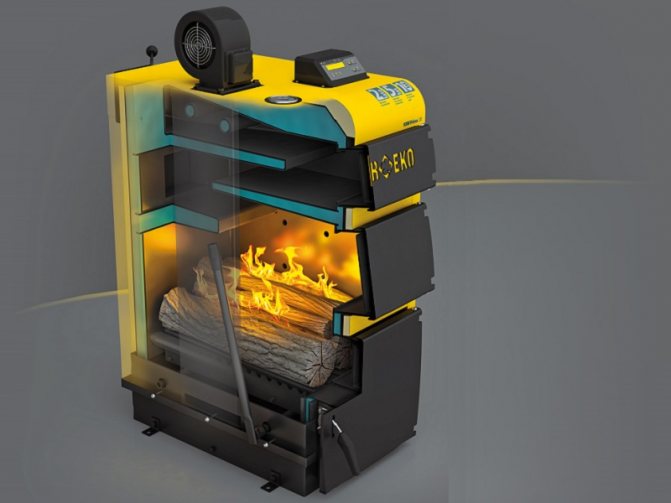

Installation of automation for solid fuel boilers
Direct connection of the boiler to a closed system is very dangerous, therefore, CH systems equipped with such units must necessarily include open expansion tanks, where water would come into contact with oxygen. This allows H2O to expand when heated, filling this container.
During installation, the correct choice of the diameter of the pipes is of great importance, which must be installed in strict accordance with the instructions provided by the manufacturer.


Features of the installation of automation depend on the model of the solid fuel boiler
What is automation for a gas boiler. General idea
Automation used for gas boilers are special devices that control the operation of heating equipment after it is started. The main purpose of automatic control devices is to ensure the safe operation of heating units and maintain an optimal temperature regime in the room.
In terms of functionality, automation is divided into two main types:
- volatile devices;
- non-volatile control devices.
The first type is volatile automation, used in autonomous heating systems, has a simpler design and operates on a residual principle. The signal from the temperature sensor about temperature changes is sent to the solenoid valve, which closes or opens, shutting off the gas supply to the gas boiler. Almost all heating boilers are equipped with this type of control equipment.
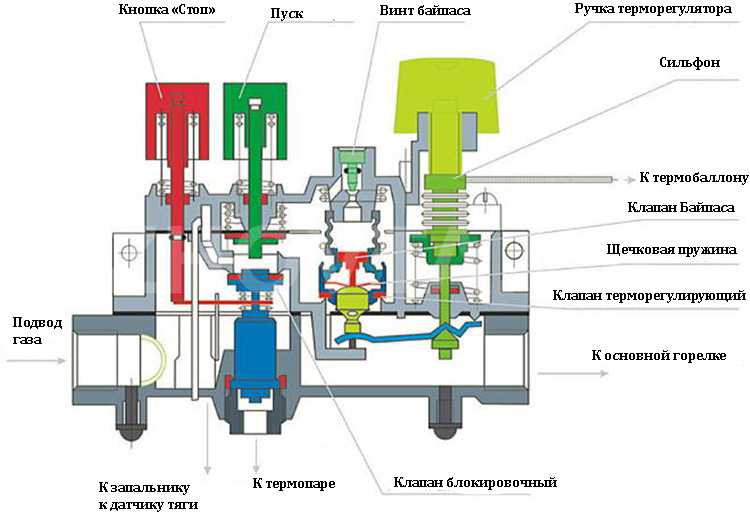

An example of a non-volatile unit of an automatic safety system for a gas boiler
The second type of automation - non-volatile devices work on the basis of the physical properties of the substance inside the closed circuit of the device. When heated, the substance expands, creating increased pressure inside the device. The high pressure actuates the gas valve, which cuts off the gas supply to the combustion chamber. The boiler is switched on in the reverse order. As the temperature decreases, the volume of the substance decreases, as a result of which the pressure in the device decreases. The valve returns to its normal position, allowing gas access to the burner. Such automation devices are on the equipment of non-volatile gas boilers. The models of the blocks of the automation system may differ only in the standard set of functions.


